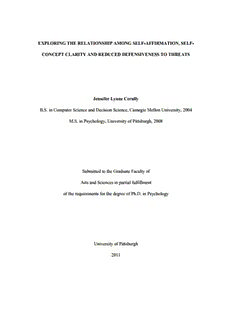
EXPLORING THE RELATIONSHIP AMONG SELF-AFFIRMATION PDF
Preview EXPLORING THE RELATIONSHIP AMONG SELF-AFFIRMATION
EXPLORING THE RELATIONSHIP AMONG SELF-AFFIRMATION, SELF- CONCEPT CLARITY AND REDUCED DEFENSIVENESS TO THREATS Jennifer Lynne Cerully B.S. in Computer Science and Decision Science, Carnegie Mellon University, 2004 M.S. in Psychology, University of Pittsburgh, 2008 Submitted to the Graduate Faculty of Arts and Sciences in partial fulfillment of the requirements for the degree of Ph.D. in Psychology University of Pittsburgh 2011 UNIVERSITY OF PITTSBURGH ARTS AND SCIENCES This dissertation was presented by Jennifer Lynne Cerully It was defended on April 14, 2011 and approved by JeeWon Cheong, PhD, Assistant Professor J. David Creswell, PhD, Assistant Professor (Carnegie Mellon University) Dissertation co-chair: William M. P. Klein, PhD, Adjunct Associate Professor Dissertation co-chair: John M. Levine, PhD, Professor ii Copyright © by Jennifer L. Cerully 2011 iii EXPLORING THE RELATIONSHIP AMONG SELF-AFFIRMATION, SELF- CONCEPT CLARITY AND REDUCED DEFENSIVENESS TO THREATS Jennifer L. Cerully, PhD University of Pittsburgh, 2011 Two studies were designed to explore the effect of self-affirmation on self-concept clarity and assess the potential mediational role of self-concept clarity in the relationship between self- affirmation and reduced defensiveness to threatening health information. It was predicted that self-affirmed participants would experience higher levels of self-concept clarity than their non- affirmed counterparts (Experiment 1). Moreover, consistent with prior research, it was hypothesized that self-affirmation would result in reduced defensiveness for people faced with a health threat relative to non-affirmed, threatened participants and to non-threatened participants (Experiments 1 and 2). Lastly, it was predicted that this relationship would be mediated by self- concept clarity (Experiments 1 and 2). In Experiment 1, 297 male and female college students wrote a self-affirming or control essay and were then exposed to a message suggesting that engaging in sexual activity increases the risk of contracting a sexually transmitted disease. In Experiment 2, 249 female college students self-affirmed in a manner that was designed to result in either low or high self-concept clarity and then read a message highlighting the link between alcohol and breast cancer risk. In both studies, defensive reactions were assessed by measuring variables such as risk perceptions, emotional responses, intentions and actual engagement in risk- reducing behavior. Experiment 1 illustrated that self-affirming did result in a small but iv statistically significant increase in self-concept clarity relative to those who did not self-affirm, but not reduced defensiveness. In Experiment 2, participants who self-affirmed in a manner that resulted in low or high self-concept clarity did not differ in consistent ways. Participants who consumed the most alcohol and completed the high self-concept clarity self-affirmation in the lab reported engaging in less unhealthy behavior (i.e., consuming fewer alcoholic drinks) in the seven to ten days after their participation relative to those who completed the low self-concept clarity self-affirmation, providing evidence that self-affirmation may result in behavioral change for some groups. The theoretical and practical implications of these experiments, as well as future directions for research on the mediators of the effects of self-affirmation will be discussed. v TABLE OF CONTENTS 1.0 INTRODUCTION…………………………………………………………………………...1 1.1 SELF-AFFIRMATION THEORY……………………………………………………2 1.1.1 STUDYING SELF-AFFIRMATION……………………………………..4 1.1.2 THE BROAD RANGING EFFECTS OF SELF-AFFIRMATION……....5 1.1.3 THE IMPORTANCE OF INVESTIGATING MEDIATORS OF THE EFFECTS OF SELF-AFFIRMATION…………………………………...6 1.1.4 KNOWN MEDIATORS OF THE EFFECTS OF SELF-AFFIRMATION…………………………………………………...7 1.2 SELF-AFFIRMATION AND THE SELF…………………………………………...10 1.2.1 SELF-CONCEPT CLARITY…………………………………………....11 1.2.2 SELF-AFFIRMATION AND SELF-CONCEPT CLARITY…………...13 1.2.2.1 STATE SELF-CONCEPT CLARITY AS A MEDIATOR……..1(cid:25) 1.3 OVERVIEW OF EXPERIMENTS AND HYPOTHESES………………………….1(cid:26) 2.0 EXPERIMENT 1…….....…..………………………………………………………………19 2.1 METHOD……………………………………………………………………………19 2.1.1 PROCEDURE……………………………………………………………19 2.1.1.1 VALUES STUDY/SELF-AFFIRMATION MANIPULATION...20 2.1.1.2 HEALTH INFORMATION STUDY…………………………....21 vi 2.1.1.3 DEPENDENT MEASURES……………………………………..21 2.1.1.4 DEMOGRAPHIC AND CONTROL ITEMS……………………22 2.1.1.5 BEHAVIORALMEASURE……………………………….…….22 2.1.1.6 DEBRIEFING……………………………………………………23 2.1.1.7 FOLLOW-UP SURVEY……………………………………...…23 2.2 RESULTS……………………………………………………………………………24 2.2.1 MANIPULATION CHECK……………………………………………..25 2.2.2 MAIN ANALYSES……………………………………………………...2(cid:25) 2.2.2.1 TESTING HYPOTHESIS 1……………………………………..26 2.2.2.2 TESTING HYPOTHESIS 2……………………………………..26 2.2.2.3 TESTING HYPOTHESIS 3……………………………………..32 2.3 DISCUSSION………………………………………………………………………..32 3.0 EXPERIMENT 2…………………………………………………………………………...3(cid:24) 3.1 OVERVIEW…………………………………………………………………………3(cid:24) 3.2 SELF-CONCEPT CLARITY SELF-AFFIRMATION PILOT TEST………………3(cid:24) 3.2.1 METHOD……………………………………………………………..…3(cid:24) 3.2.2 RESULTS………………………………………………………………..3(cid:26) 3.2.3 DISCUSSION……………………………………………………………3(cid:28) 3.3 MAIN EXPERIMENT………………….………………………………………........(cid:23)(cid:19) 3.3.1 METHOD………………………………………………………………..(cid:23)(cid:19) 3.3.1.1 VALUES STUDY/SELF-CONCEPT CLARITY MANIPULATION……………………………………………….(cid:23)(cid:19) 3.3.1.2 HEALTH INFORMATION STUDY……………………………(cid:23)(cid:19) vii 3.3.1.3 DEPENDENT MEASURES…………………………………..…4(cid:20) 3.3.1.4 DEMOGRAPHIC AND CONTROL INFORMATION…………4(cid:20) 3.3.1.5 DEBRIEFING……………………………………………………4(cid:20) 3.3.1.6 FOLLOW-UP……………………………………………………4(cid:21) 3.3.2 RESULTS………………………………………………………………..4(cid:21) 3.3.2.1 DETERMINING ALCOHOL CONSUMPTION……………….43 3.3.2.2 TESTING HYPOTHESIS 4……………………………………..43 3.3.3 DISCUSSION……………………………………………………………48 4.0 GENERAL DISCUSSION…………………………………………………………………51 4.1 IMPORTANCE……………………………………………………………………...52 4.2 LIMITATIONS………………………………………………………………………55 4.3 FUTURE DIRECTIONS…………………………………………………………….58 APPENDIX A. Health Article for Experiment 1……………………………………………..60 BIBLIOGRAPHY………………………………………………………………………………62 viii LIST OF TABLES TABLE 1. βs, t values, and p values for effect of sexual activity..……………………………...28 TABLE 2. Mean number of items in kit and purchase price for each condition………………...31 ix LIST OF FIGURES FIGURE 1. Representation of global self-integrity (adapted from Sherman & Cohen, 2006)………………………………………………………………………….3 FIGURE 2. Model of mediation of self-affirmation and reduced defensiveness relationship by high state self-concept clarity………………………………………16 FIGURE 3. The interaction of condition and alcohol consumption on breast cancer worry……45 FIGURE 4. The interaction of condition and alcohol consumption on perceived risk of breast cancer for others……………………………………………………………..46 FIGURE 5. The interaction of condition and alcohol consumption on number of alcohol drinks consumed in 7-10 days after laboratory session…………………….48 x
Description: